This is an old revision of this page, as edited by StSeanSpicer (talk | contribs) at 04:01, 8 April 2022 (→Modern era: The economist article only cites RPG-7s as an example of Ukraine's broader arsenal of man portable HEAT weapons). The present address (URL) is a permanent link to this revision, which may differ significantly from the current revision.
Revision as of 04:01, 8 April 2022 by StSeanSpicer (talk | contribs) (→Modern era: The economist article only cites RPG-7s as an example of Ukraine's broader arsenal of man portable HEAT weapons)(diff) ← Previous revision | Latest revision (diff) | Newer revision → (diff) Vehicle armor to protect against shaped charge warheads

Slat armor (or slat armour, in British English), also known as bar armor, cage armor, and standoff armor, is a type of vehicle armor designed to protect against high-explosive anti-tank (HEAT) attacks, as used by rocket-propelled grenades (RPG). It takes the form of a rigid slatted metal grid fitted around key sections of the vehicle, which disrupts the shaped charge of the warhead by either crushing it, preventing optimal detonation from occurring, or by damaging the fuzing mechanism, preventing detonation outright. Although slat armor is effective against incoming missiles, it does not offer complete protection – as many as 50% of missile impacts are unimpeded by the slat design. Slat armor is more likely to be effective if the cage spacing is less than the diameter of the incoming RPG round, which is commonly 85 mm in diameter.
Combat history
World War II

The German Wehrmacht was the first employer of cage armor during World War II, using Drahtgeflecht-Schürzen (English: "wire mesh skirts") to fortify its tanks against shell fire. It was found to be just as effective as the steel plate Schürzen also being utilized. In March 1943, Adolf Hitler ordered all new Sturmgeschütz, Panzer III, IV, and Panthers be outfitted with Schürzen of either the wire mesh or steel plate type. However, the wire mesh was not as easy to mass-produce as steel plate Schürzen or armored skirts. Soviet Red Army tanks, faced with the new and highly effective German Panzerfaust, were similarly outfitted with "bedspring" armor made from expanded metal mesh grating panels.
However, Schürzen were designed to stop Soviet PTRD-41 anti-tank rifles, and proved ineffective against Bazooka and Panzerschreck anti-tank rockets in US and German tests.
Cold War era
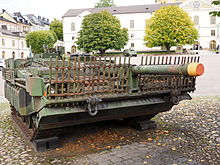
In the Vietnam War, slat armor was commonly used on the sides of American patrol barges and boats. The CCB-18 is a surviving example of the Mobile Riverine Force which used such armor. Wire fencing was also placed on vehicles such as the M113 to defeat Vietcong RPGs. The Swedish Stridsvagn 103 of the same era employed a much heavier front-mounted metal grid to protect against incoming projectiles.
Modern era
In modern times, slat armor has seen use on the Israel Defense Forces (IDF) Caterpillar D9R armored bulldozer, the Force Protection Buffalo MPV MRAP vehicle, the General Dynamics Stryker, Ukrainian BTR-4, the Warrior infantry fighting vehicle, the M113 APC, the British Challenger 2, the Leopard 2A6 main battle tank, and Russian T-62 tanks. Slat armor is favored over traditional plate armor not only due to its effectiveness against shaped-charge warheads, but also due to its much lighter weight, which improves vehicle maneuverability.
Slat armor was first used on the Israeli IDF Caterpillar D9R armored bulldozer in 2005, and was installed in large numbers in 2006. Around the same time in 2005, slat armor was first proposed for the Stryker by a team of experts from the Army Research Laboratory (ARL), the Developmental Test Command, and the Aberdeen Test Center (ATC) to protect the vehicle from RPGs. Within seven days, the ARL and ATC designed and produced the first prototype, which was later mass produced at the Lima Army Tank Plant in Ohio and implemented in different variants of the Stryker. The design of the slat armor has the cage placed 50 cm ahead around the vehicle, allowing an RPG warhead to explode at a safe distance. In addition, the slat armor on the Stryker vehicles is reportedly effective against HEAT rounds.
In 2007, BAE Systems developed an extremely lightweight aluminum slat armor system called the LROD, which was initially used on the Buffalo MPV, and which was claimed to weigh half the amount of comparable steel designs. BAE later equipped several US Army RG-31s with a variant of the LROD system, and also developed the system for its RG-33 vehicles, the Caiman and the JERRV. Slat armor is also fielded on the American M1 Abrams as part of the TUSK urban warfare series. In the Syrian Civil War, ISIS, the Free Syrian Army and Syrian Army equipped their armored vehicles with homemade slat armor to protect them from RPG impact.
In August 2016, Russia introduced bar-slat armor developed by NII Stali and Uralvagonzavod to increase protection of Russian armored vehicles against RPG and recoilless rifle HEAT rounds by 55-60%. The armor can be integrated with a variety of old-Soviet and Russian vehicles including the BTR-50/BTR-60/BTR-70/BTR-80/82/BTR-90, BMP-1/BMP-2/BMP-3, BRDM-2/BRDM-3, and T-14 Armata, with the full kit adding 1,000 kg (2,200 lb) of weight.
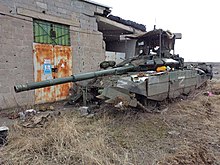
In late 2021, various Russian tanks were observed with top-mounted improvised slat armor made from steel grilles. In 2022, during the Russian invasion of Ukraine where they saw combat usage, they were termed pejoratively as "cope cages" by online communities, expressing skepticism over their real-world effectiveness, based on the assumption by military analysts that the armor was most likely designed in an attempt to mitigate the threat of top-down anti-tank missiles such as the FGM-148 Javelin, NLAW, and other top-attack munitions. These implementations add weight to the tank, increase its visual profile, and make it more difficult for the crew to escape from the tank. In December 2021, the Ukrainian Army released video of a military exercise in which an armored fighting vehicle (apparently a BTR fitted with a T-64-like turret) protected by armor of this sort was destroyed by a Javelin missile. Analysts have also speculated that they may instead be used as a countermeasure against HEAT warheads from weapons such as RPG-7s fired from above during urban combat, loitering munitions, or against drone attacks, as a response to lessons learned from the 2020 Nagorno-Karabakh war. The lack of uniformity between the makeshift cage variants made from different meshes and iron fences suggest that they are largely improvised by the tank crews, and are not standard issue.
Gallery
-
Slat armor on an upgraded M113 armored personnel carrier in 2008
-
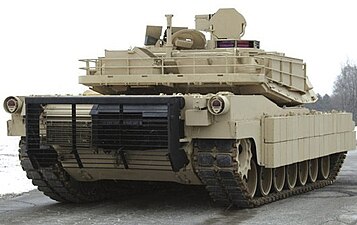 Slat armor protecting the engine exhaust port at the rear of the hull of an M1 Abrams
Slat armor protecting the engine exhaust port at the rear of the hull of an M1 Abrams
-
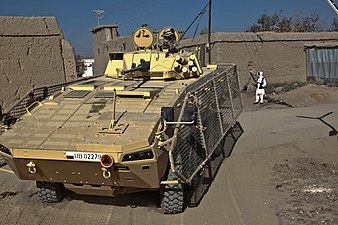 Lighter netting type fitted to a Polish KTO Rosomak in Afghanistan, 2010
Lighter netting type fitted to a Polish KTO Rosomak in Afghanistan, 2010
-
 Slat armor on a BvS 10 Viking ATV in 2012
Slat armor on a BvS 10 Viking ATV in 2012
-
 Slat armor of an IDF Caterpillar D9 armored bulldozer
Slat armor of an IDF Caterpillar D9 armored bulldozer
-
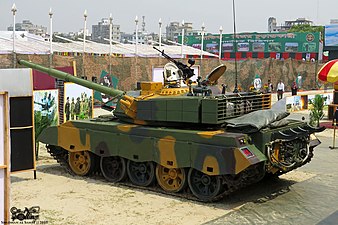 Slat armor protecting the rear of the turret of a Type 59G Durjoy tank
Slat armor protecting the rear of the turret of a Type 59G Durjoy tank
-
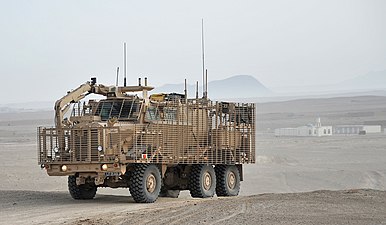 Buffalo Vehicle with attached slat armor in Afghanistan
Buffalo Vehicle with attached slat armor in Afghanistan
See also
References
- "BAE’s LROD Cage Armor". Defense Industry Daily. 17 August 2012. Retrieved 13 February 2015.
- ^ Yap, Chun (September 2012). "The Impact of Armor on the Design, Utilization and Survivability of Ground Vehicles: The History of Armor Development and Use". Naval Postgraduate School – via Defense Technical Information Center.
- "Sturmgeschütze vor!" StugIII.com. Retrieved 12 February 2013.
- Bazooka vs Panzer, Battle of the Bulge 1944, Steven J. Zaloga, Osprey, p. 34, 38
- CCB Memorial Fund Archived 2014-10-06 at the Wayback Machine. MRFA.org. Retrieved 12 February 2013.
- ^ "The MRAP Cage Fight". DefenseTech.org. 18 July 2007. Retrieved 4 October 2012.
- "Background — CF Leased & Purchased Leopard 2 A6M / 2 A4 Tanks" Archived 2008-04-16 at the Wayback Machine. CASR. Retrieved 12 February 2013.
- "A Russian serviceman reads next to a T-62 tank in Gori near South Ossetia, August 15, 2008". Reuters via Flickr. Retrieved 1 April 2012.
- "Slat Armour for Stryker". Defense-Update.com. 2005. Retrieved 12 February 2013.
- Rooney, John (January 2007). "Armor Testing, An Example of T&E for Rapid Acquisitions". ITEA Journal: 4–6 – via Defense Technical Information Center.
- Russia develops bar-slat armour to protect combat vehicles - Armyrecognition.com, 19 August 2016
- Roblin, Sebastien. "Russian Tanks Massing Near Ukraine Sport Mods Against Drones, Javelin Missiles". Forbes. Archived from the original on 2022-03-11. Retrieved 2022-03-11.
-
- "Russian tanks in Ukraine are sprouting cages". The Economist. March 14, 2022. Archived from the original on March 16, 2022.
They have indeed been mockingly dubbed by Western analysts as 'emotional support armour' or 'cope cages'. Superficially, they are an example of what is known in military circles as field-expedient armour—in other words, stuff that has been added to vehicles after they have entered service.
- "Igazi tankszörnyet zsákmányoltak az ukránok". Portfolio.hu (in Hungarian). March 2, 2022. Archived from the original on March 15, 2022.
Érdekes egy szót említeni a „kutyaólként" vagy "csirkeketrecként," angolszász forrásokban „cope cage," vagyis durván „dolgozd fel ketrecként" emlegetett improvizált páncélzatról a tornyon. A páncélzat célja az lenne, hogy megvédje a harcjárműveket a felülről érkező drónrakétáktól vagy páncéltörő rakétáktól.
[It is interesting to mention the terminology surrounding the improvised armour on the tower, referred to as 'dog kennel' or 'chicken coop' in Hungarian, or 'cope cage' in Anglo-Saxon sources. The purpose of the armor would be to protect the combat vehicles from drone missiles or armor-piercing rockets coming from above.] - James Dwyer (March 10, 2022). "How do anti-tank missiles work, and how helpful might they be for Ukraine's soldiers?". Australian Broadcasting Corporation. Archived from the original on March 15, 2022.
These are colloquially termed 'cope cages' by various communities on the internet. Of course, they will do little to minimise the impact from a missile, but they do demonstrate that Russian soldiers are fearful of the threat the missiles present.
- "What to know about the role Javelin antitank missiles could play in Ukraine's fight against Russia". Washington Post. March 12, 2022. Archived from the original on March 12, 2022.
Social media has been littered with photos of destroyed Russian tanks with cages. The images have acquired a symbolic resonance so quickly that Internet users have coined the term 'cope cage' earning a page on the Internet's primary meme directory.
- "Russian tanks in Ukraine are sprouting cages". The Economist. March 14, 2022. Archived from the original on March 16, 2022.
-
- "Russian tanks in Ukraine are sprouting cages". The Economist. March 14, 2022. Archived from the original on March 16, 2022.
They appear to be oriented in a way that protects only against attacks from above. In principle, that might help against Javelins, which have a 'top attack' mode ... even if the cage sets off a Javelin's precursor warhead, the main charge is still more than powerful enough to punch through the top armour and destroy the tank
- Alia Shoaib (March 26, 2022). "Russian soldiers appear to be fixing makeshift cages to the turrets of their tanks in a crude effort to protect themselves against Ukraine's anti-tank missiles". Business Insider. Archived from the original on March 26, 2022.
"The cages are supposed to defend against anti-tank weapons that strike the top of the vehicle, where the armor is the thinnest. "The idea is that if you set off a bazooka or a Panzerfaust... they're set off early and so they don't hit the tank itself..." Crump explained. However, the cages are largely ineffective against the modern anti-tank weapons used by the Ukrainians, such as the Javelin and NLAW... Many modern weapons are designed to counter that sort of protection
- "Russian tanks in Ukraine are sprouting cages". The Economist. March 14, 2022. Archived from the original on March 16, 2022.
- Alia Shoaib (March 26, 2022). "Russian soldiers appear to be fixing makeshift cages to the turrets of their tanks in a crude effort to protect themselves against Ukraine's anti-tank missiles". Business Insider. Archived from the original on March 26, 2022.
"The advantage Russian tanks have is that they're super small and very low, making them easy to hide. When you start doubling the height, you're getting rid of some of the advantages of the vehicle," Crump said. The cages also make it harder for the crew to get in and out of the vehicles, according to Crump.
- Thomas Newdick (23 December 2021). "Ukrainian Troops Test Javelin Missile Against Russian Cage-Style Improvised Tank Armor". The Drive. Brookline Media Inc.
-
- "Russian tanks in Ukraine are sprouting cages". The Economist. March 14, 2022. Archived from the original on March 16, 2022.
Another idea is that the cages are a response to the conflict in 2020 between Armenia and Azerbaijan, over Nagorno-Karabakh, in which large numbers of Russian-made Armenian tanks were destroyed from above by MAM-Ls ... A third possibility is that the cages are meant as protection against RPGs ... which are being fired at tanks from above. This ... is a preferred tactic in urban warfare, where buildings offer shooters the necessary elevation.
- "Les «cope cages», protections bricolées et moquées des chars russes impuissants". Slate.fr (in French). March 23, 2022. Archived from the original on March 23, 2022.
Ces structures approximatives sont ce qu'il est devenu coutumier d'appeler des cope cages en anglais –des «cages pour faire avec», pour traduire grossièrement l'expression. Elles sont le résultat des observations par l'armée russe du conflit opposant Azerbaïdjan et Arménie dans le Haut-Karabakh.
[It has become customary to call these makeshift structures "cope cages" in English, an expression which roughly translates to "cages pour faire avec". They are the result of observations made by the Russian army towards the conflict between Azerbaijan and Armenia in Nagorno-Karabakh.] - Newdick, Thomas. "Russian T-80 Tank With Improvised Anti-Drone Armor Reportedly Appears In Crimea". The Drive. Archived from the original on 24 February 2022. Retrieved 2022-03-11.
- "Russian tanks in Ukraine are sprouting cages". The Economist. March 14, 2022. Archived from the original on March 16, 2022.
- Alia Shoaib (March 26, 2022). "Russian soldiers appear to be fixing makeshift cages to the turrets of their tanks in a crude effort to protect themselves against Ukraine's anti-tank missiles". Business Insider. Archived from the original on March 26, 2022.
The lack of uniformity of the cages, and the fact that they are only seen on some tanks, shows that Russian units are largely improvising them
External links
 Media related to Slat armor at Wikimedia Commons
Media related to Slat armor at Wikimedia Commons